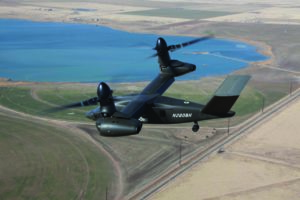Bell [TXT] has selected GE Aerospace [GE] to develop the digital backbone for the Army’s Future Long Range Assault Aircraft (FLRAA), the companies said on Thursday.
GE Aerospace said it will specifically provide the “Common Open Architecture Digital Backbone (COADB), Voice and Data Recorder, and the Health Awareness System” for Bell’s V-280 Valor tiltrotor aircraft as part of an “open, scalable, high-speed data infrastructure.”

“Our open systems technologies and experience provide the customer with the ability to make aircraft system modifications for this next generation of vertical lift aircraft,” Amy Gowder, GE Aerospace’s president and CEO for defense and systems, said in a statement. “This changes how aircraft are updated and maintained, and it ensures that our soldiers have an advantage on the battlefield.”
Bell’s V-280 Valor was named the winner of the FLRAA competition last December, beating out a Sikorsky [LMT] and Boeing [BA] team’s Defiant X coaxial rigid rotor helicopter offering for the program to find an eventual UH-60 Black Hawk helicopter replacement (Defense Daily, Dec. 5).
The Army’s initial FLRAA deal to Bell is worth up to $1.3 billion but could total $7 billion if all options are picked up.
Bell notified GE Aerospace of its decision to select the company to work on FLRAA after the award decision was announced last December, a GE Aerospace spokesperson told Defense Daily, while adding the value of its deal to work on the program is undisclosed.
“This is a foundational effort to improve weapon system capability and affordability for the Army by ensuring architectural alignment for integration of new technology,” Ryan Ehinger, Bell’s senior vice president and program director for FLRAA, said in a statement. “This collaborative approach provides the Army a vendor-agnostic path to explore new systems and capabilities – delivering soldiers the right tools for success in multi-domain missions.”
GE Aerospace said developing the digital backbone with a modular open systems approach, or MOSA, will enable “rapid testing, verification, and fielding of mission-focused capabilities for future vertical lift programs.”
“By leveraging GE’s experience in delivering open avionics architecture, the Army will realize the benefits of Modular Open Systems Approach designs from the outset of the Future Vertical Lift programs. Providing an open, high-speed, secure, interoperable system in the digital backbone is critical to support our customer,” Gowder said.
GE Aerospace added the voice and data recorder for FLRAA is an “end-to-end system to acquire, transfer, process, and analyze flight and voice data,” while the Health Awareness Systems “builds on decades of commercial and military operation and has saved operators millions of dollars and increased mission readiness with predictive maintenance.”
Army officials have previously said the plan is to have Bell deliver the first physical prototypes for FLRAA in 2025, with continued digital design and work on the virtual prototype in the near-term as the program moves toward a Milestone B decision likely in the third quarter of fiscal year 2024 (Defense Daily, May 1).